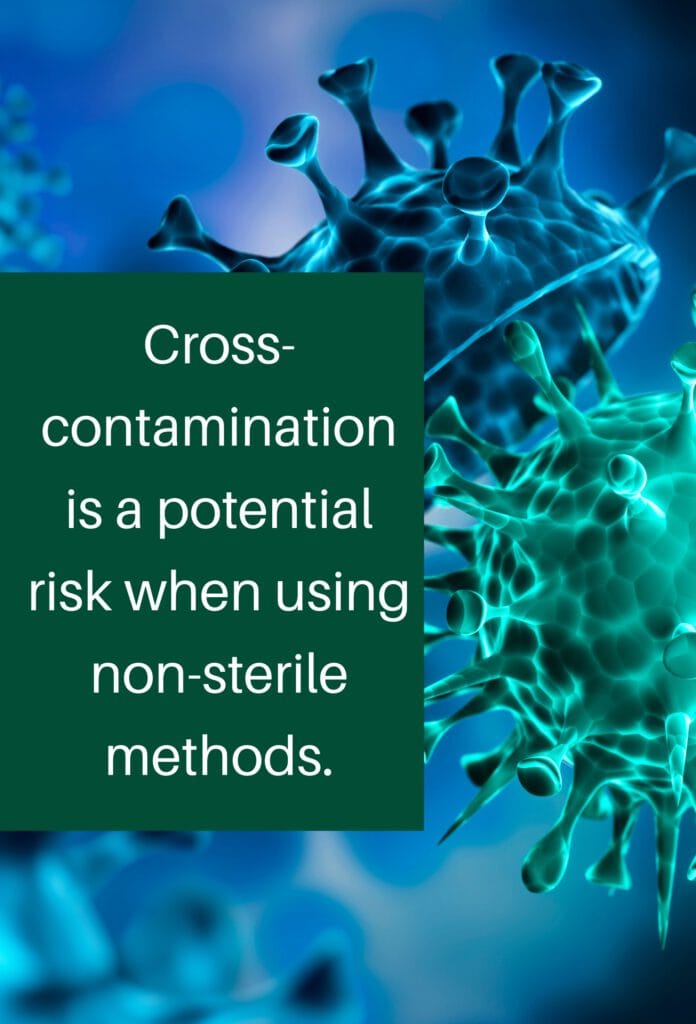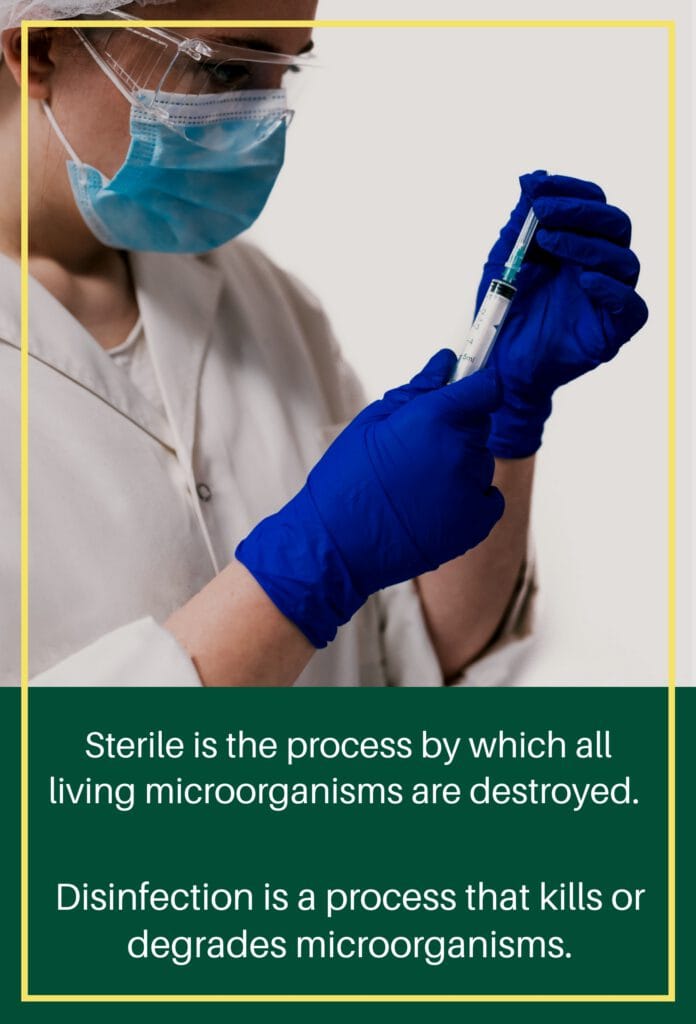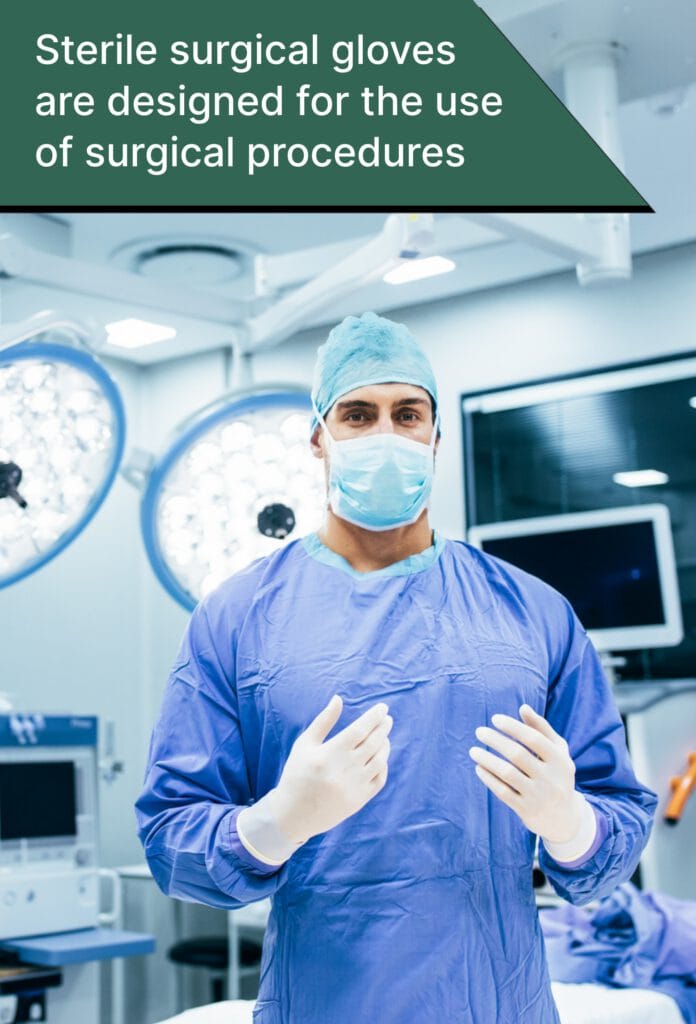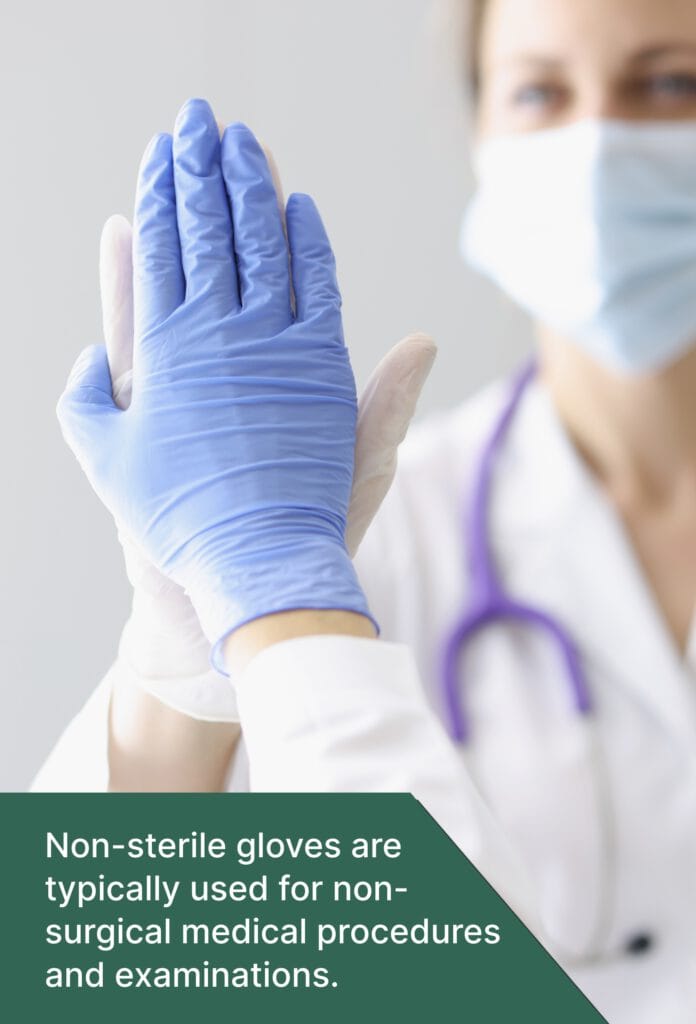Do you ever get confused about the difference between sterile and nonsterile gloves? In this article, we will go over the different types of gloves and their purposes, so that you can make an informed decision when it comes to selecting the right type of gloves for your needs.
Table of Contents
- What is the Meaning of Non-sterile?
- What is the Meaning of Sterile?
- Difference Between Sterile and Disinfection?
- FDA Methods of Sterilization.
- Gloves Sterilized Through Ethylene Oxide
- Gloves that Are Sterilized by Gamma Rays.
- The Differences Among Sterile, Aseptic and Clean Techniques
- What is the Difference Between Sterile and Non-Sterile Gloves?
- FDA Guide for Verifying the Quality of Sterile Gloves.
- FDA Guide About Non-Sterile Gloves
- Different Types of Sterile Gloves:
- Different Material Types of Sterile Gloves:
- Different Type/Material of Non-sterile gloves:
- Sterile Glove Use
- Nonsterile Glove Use
- Should I Use Sterile Or Non-Sterile Gloves? What to Consider?
- Q&A
- Are Non-Sterile Gloves Still Safe?
- Which of the gloves should I choose between sterile and of non-sterile Gloves?
- Are non-sterile gloves safe for food?
- Which type of glove is better: latex or nitrile?
- What are the benefits of using sterile vs nonsterile gloves?
- Which kind is more expensive, this one or that one?
What is the Meaning of Non-sterile?

Non-sterile means that there is no sterilization (cleaning) of the products or environment in which the products or environment is to be used. This means that there is a risk of cross contamination. If you are using a product or environment that has not been sterilized, you should take precautions to minimize this risk.
What is the Meaning of Sterile?
Sterilization is a process that destroys all bacterial life, while disinfection eliminates most or all pathogenic microorganisms. Although governing bodies such as the FDA can test to see if something is sterile, sterilization techniques do not guarantee 100% sterility. Sterilization is guaranteed if a sterilization technique is employed for long enough time so that the probability of surviving is less than the probability of survival of one microorganism.
Difference Between Sterile and Disinfection?
Are you unsure of the difference between sterile and disinfection? You’re not alone. In fact, this confusion is one of the biggest reasons why people don’t take steps to protect their health during food preparation.

FDA Methods of Sterilization.
Sterile technique is the technique used for sterile procedures such as surgical procedures. There are 4 sterile techniques that the FDA uses to sterilize items which are more effective as follows:
Dry heat : Dry heat is a sterilization method that allows for devices to be sterilized without the risk of moisture damage. Items are placed in a high temperature (300-340 F) cabinet for up to 150 minutes.
Ethylene oxide: The gas containing ethylene oxide is used in sterilization. It is possible that if breathed in it can cause harm. It is possible that the process can take up to six hours, and after sterilization, the devices must be aerated in order to remove any traces of the gas.
Moist heat or steam : The use of high pressure saturated steam is a widely used sterilization method. In this method, you expose the medical supplies to a temperature of 250 degrees for at least 30 minutes. The dwell time in a pre-vacuum sterilizer is reduced to just four minutes.
Radiation: Manufacturers of medical devices have to expose their products to gamma rays in a room that’s shielded from the outside. Gamma rays from cobalt-60 are destroying microbes’ DNA. In some products, it can break down some polymers, and in other products, it can strengthen them. It is often used as a substitute for ethylene oxide.
Gamma rays and ethylene oxide are used to make sterile gloves. Gloves are made of nitrile and other synthetic materials that are not destroyed by gamma rays or ethylene oxide.
Gloves Sterilized Through Ethylene Oxide
Ethylene oxide is a gas that is used in industrial and medical sterilization processes. It is a strong oxidant that can kill many types of bacteria, viruses, and fungi. Gloves are often sterilized through ethylene oxide to reduce the risk of cross-contamination.
Ethylene oxide is an effective way to sterilize gloves and other medical equipment, but it must be used with great caution due to the dangers associated with its use. There is a stringent normative in Europe called ATEX (2014/34/UE) that ensures the safety of personnel, machine and environment when using ethylene oxide gas.
Once gloves are brought into the sterilization chamber, it is necessary to undergo several vacuum cycles. The air is removed. Then nitrogen and steam are pumped into the chamber. Then the Ethylene Oxide or EO is injected into the chamber, and left there to stay until the gloves have fully been sterilized.
Each of those steps takes an average of 10 to 12 hours. Next, the majority of the EO is removed through several vacuum cycles by injecting nitrogen into the chamber. Then pull it back out. Ethylene oxide is captured, and it is routed to a scrubber. There, they combine the ethylene oxide with water and sulfuric acid. This liquid chemical, which we know as antifreeze, is now being repurposed for many commercial and industrial purposes. For example, polyester fibers are made from this liquid chemical.
Gloves that Are Sterilized by Gamma Rays.

There are many healthcare industries that process radiation. One of them uses cobalt-60 as a source of gamma radiation. There are three reasons why cobalt-60 is the best metal for radiation processing. One of them is that they are very energetic (gamma rays) and have a very long half-life of 5.27 years.
When the glove is processed, like ethylene oxide, it is said to be a cold process, so the gloves will not become very hot during the process. So it is possible to sterilize heat sensitive items such as latex gloves, vinyl gloves and nitrile gloves. Gamma radiation does not need to be conditioned by humidity, temperature or pressure, and it is also suitable for applying to gloves that are packaged.
By irradiating gamma rays, you kill bacteria because the DNA of bacteria is broken down. This inhibits bacterial division. It is possible for the energy from gamma rays to pass through the gloves and interrupt the pathogens that cause contamination. It will cause changes at the molecular level that cause bacteria to be killed or rendered incapable of reproducing. Gamma-ray radiation is very permeable and does not leave any residue. That is why sterilized gloves are free of germs and chemicals.
The Differences Among Sterile, Aseptic and Clean Techniques
It’s easy to misunderstand the differences between aseptic techniques, sterile techniques and clean techniques. Aseptic and sterile techniques are used to keep objects or patients sterile. Aseptic and sterile are both terms used to refer to the same objective of reducing or eliminating potentially harmful microorganisms and involves the exclusion of microorganisms from a medical environment. However, the differences between the two concepts are crucial when it comes to cleanroom and pharmaceutical environments.
Aseptic technique and clean technique are used to prevent the exposure of microbes during medical examinations and procedures. Aseptic technique is used to maintain sterility while clean Technique is lowered the number of pathogen.
The sterile technique involves methods such as dry heat, ethylene oxide or gamma rays to produce a sterilized device. The aseptic technique requires creating barriers, preparing patients and equipment, controlling the environment and following contact guidelines. Aseptic technique and sterile technique prevent the exposure of microbes while clean Technique lowers the number of pathogen in a patient.
What is the Difference Between Sterile and Non-Sterile Gloves?

Gloves that are used in many medical procedures have to be sterilized. In fact, they aren’t always necessary. Both sterile and non-sterile gloves have been used in medical settings and have an important role to play.
The non-sterile glove or examination glove designation for medical devices means that they are not intended to be used by those who are not certified in their use. They must meet rigorous safety and quality standards, and should only be used by those with the proper training. Gloves play an important role in protecting patients from pathogens, and should always be worn when handling or caring for a patient.
Sterile gloves are 100% safe and microorganism free to use during surgical procedures. They have a very high AQL standard and strict packaging and transportation standards.
FDA Guide for Verifying the Quality of Sterile Gloves.
Sterile gloves that meet the FDA minimum standard for assessing the effectiveness of sterilization techniques. The acceptable quality level of pinholes (AQL) is measured with a microscopic examination. The acceptable quality level for gloves depends on the risk involved in using them.
Gloves that are sterile and that are good quality to protect patients from infection. Sterile gloves must have lower AQL than

Non sterile gloves. Sterile gloves must have an AQL of 1.0 to 1.5. An AQL of 1 means that 1% of the gloves will have pinholes, and so on. Non sterile gloves must have an AQL of 1.5 to 2.5, and as much as 2.5% of gloves will have pinholes. When you wear gloves that aren’t sterilized, the price of these gloves is higher than the price of sterilized gloves because they undergo more rigorous sterilization procedures.
FDA Guide About Non-Sterile Gloves
Non-sterile gloves do not conform to the strict standards set by the FDA Standards Assurance Level (SAL) but must still be tested by the FDA after sterilization to ensure they meet standard assurance level (SAL).
The glove sterilization standards recognized by the FDA include: ANSI/AAMI/ISO 11135 (Sterilization control and validation of Ethylene oxide), AAMI/ISO (about information on sterilization of radiation and healthcare products) and AAMI/CDV 11137 (Sterilization of healthcare products and radiation).
Different Types of Sterile Gloves:
A special glove is very useful for preparing pharmaceuticals, dental procedures, medical examinations, and minor surgery. In the preparation process, potential bodily fluids and blood exposure are also included. The medical gloves that people choose for healthcare purposes include:
Sterile Exam Gloves:
Sterile exam gloves or sterile disposable gloves protect the hands while performing an examination or non-surgical procedures. They are made of soft material to protect the skin, but they have a latex or vinyl coating that help seal in body fluids and keeps them from touching your hands.
Sterile Surgical Gloves:
Sterile surgical gloves are made of a tougher, synthetic material and are worn during surgery to protect the hands and wrists from cuts, dirt, and other debris.

Different Material Types of Sterile Gloves:
Sterile gloves come with many material choices such as Sterile non-latex gloves and Sterile latex gloves. Latex is often known to cause skin irritation and allergic reactions while non-latex gloves protect the skin from adverse allergens. Here are some material of sterile gloves
Sterile Nitrile Gloves :
Created out of nitrile rubber rather than natural latex. Sterile Nitrile gloves are stronger, tear proof, chloroform resistant and lighter than latex gloves. Sterile nitrile was introduced into medical use as an alternative choice over natural rubber. This makes them perfect to use as protection against chemical exposures, infections blood wounds, and other similar biohazardous situations.
Sterile Vinyl Gloves :
These gloves are made of PVC (Polyvinyl Chloride) as opposed to rubber. The materials that make up this glove are more durable than latex and also cheaper than nitrile gloves. Although they’re still not considered sterile, these are regularly used for handling medical waste. Comparatively cheaper and perfectly suited for surgical use, they are not very durable and are not very good for use against biomedical hazards and chemical exposure.
Sterile Latex Gloves :
These gloves are made from natural latex. Many healthcare professionals are concerned about latex allergies because they believe that it may cause them to have a severe reaction to hospital equipment or their environment.
Gloves made from non-latex materials are more resistant to wear and tear and are completely non-irritant on the skin.
Different Type/Material of Non-sterile gloves:

All the Type/materials that make sterile gloves are identical to the materials that make non-sterile gloves. There is a difference between gloves that are processed sterile or not. However, there are some materials that are very popular for making non-sterile gloves, which are:
PPE Gloves – Created out of polypropylene, these types of gloves were accepted for healthcare purposes. With the exclusion of natural rubber that was produced from latex.
Vinyl Gloves: These gloves are made of vinyl rubber. The advantage of vinyl gloves over latex is that they provide a superior grip.
Sterile Glove Use
The main purpose of Sterile Glove and Sterile Glove is to prevent surgical site infections (ssi) and provide hand hygiene. In the event that a physician prescribes sterilized gloves or surgical gloves, it is strongly recommended that those gloves be worn when you perform invasive procedures, higher risk, infection control work and operations that involve touching sterile parts of your body. Some of the other applications might include: micrographic surgery, surgical wound care, CPR, catheter insertion and care, tracheotomies in neonates, premature infants, etc.
Nonsterile Glove Use
Nonsterile gloves are acceptable for scenarios such as laboratory work, medical research and procedures where glove use is necessary. However, nonsterile gloves aren’t the best choice in many scenarios such as respiratory applications or high moisture situations. Nonsterile Glove use in these scenarios would become less relevant such as cleaning, patient care, dentistry, outpatient dental procedures, food handling or relevance.
Should I Use Sterile Or Non-Sterile Gloves? What to Consider?
There is no one-size-fits-all answer to this question, as the best way to protect yourself and your patients depends on the type of gloves you are using and the particular circumstances. Whether you’re a professional health care provider or just someone with common tasks like brushing your teeth, it’s important to use the right gloves for the job However, here are a few guidelines that can help you decide whether or not to use sterile or non-sterile gloves:
- Always use sterile gloves when handling any kind of infectious material, such as blood or tissue.
- Use non-sterile gloves when working with materials that are not infectious, such as cleaning supplies.
- Always sanitize your hands before and after handling any kind of glove material.
- Follow the specific protocol for the type of glove you are using – some require sterilization, others do not.
Q&A
Are Non-Sterile Gloves Still Safe?
Non-sterile gloves are just as safe as those that have been sterilized. They are also very helpful when performing certain minor medical procedures. If you use clean products, always follow standard infection control procedures, and make sure that your gloves are kept clean while you use them. When used properly, irises can act as a barrier between healthcare professionals and their patients, increasing the likelihood of that person being safe.
Which of the gloves should I choose between sterile and of non-sterile Gloves?
Most healthcare facilities use FDA-approved examination gloves or sterile surgical gloves when performing medical procedures. Sterile gloves are essential for protecting the health of the patient, and using them correctly can save your organization money in the long run. Non-sterile gloves have many other applications outside of healthcare settings, making them a good option if sterile Gloves are not available.
Are non-sterile gloves safe for food?
There is much debate about whether it is safe to use non-sterile gloves when handling food. Some people feel that non-sterile gloves are necessary in order to prevent the spread of food-borne illnesses, but others are convinced that there are too many risks for people to be protected by wearing non-sterile gloves.
It is not recommended that people use non-sterile gloves when handling food. There is not enough evidence to show that these gloves are effective in preventing food-borne illness. In fact, the FDA has warned consumers that using non-sterile gloves may actually increase their risk of getting food poisoning.
What is important is that each person decides whether or not they feel comfortable wearing non-sterile gloves when handling food. If you are not sure whether or not the items are safe, it would be best to avoid them entirely.
Which type of glove is better: latex or nitrile?
There is no definitive answer to this question since both gloves have their pros and cons. However, if you are looking for a glove that is resistant to some types of bacteria, I would recommend opting for a nitrile glove. Nitrile gloves are also less likely to cause skin irritation than latex gloves.
What are the benefits of using sterile vs nonsterile gloves?
There are a lot of pros and cons to using sterile gloves over nonsterile ones, so it is important to weigh the benefits before you decide. Those are just a few of the key points that you should consider.
1. With the help of sterile gloves, you are protected from a possible infection. By wearing sterile gloves, you will avoid becoming sick while you are working in a lab or at a hospital.
2. Put on sterile gloves that will protect the tools you’re working with from contamination. If you use sterile gloves, you may avoid bringing in harmful bacteria or viruses into your lab or workplace.
3. Sterile gloves are a good way to prevent cross-contamination. When you handle some different types of things that need to be handled with gloves, wearing sterile gloves will help keep everything clean and safe.
4. Sterile gloves are more easily cleaned than nonsterile gloves. The dirt of nonsterile gloves is easily spread, which can lead to cross-contamination and health risks. By wearing sterile gloves, you are making it easier to keep everything clean and infection-free.
Which kind is more expensive, this one or that one?
Sterile gloves are more expensive than nonsterile. However, the cost of using a pair of sterile gloves can differ from one company to another. As well as the brand, you should also consider the quality and size of the product if you want them in your budget without compromising on their benefits. If you want to buy the best nitrile gloves, visit
